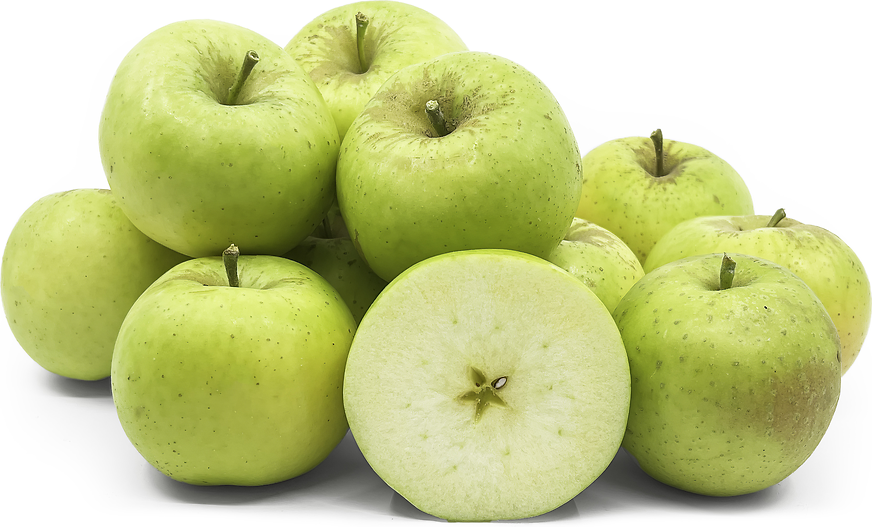


Greensleeves Apples
Estimated Inventory, lb : 0
Description/Taste
Greensleeves apples are moderately-sized, somewhat uniform fruits with a round, oval, to oblate shape. The skin is smooth, semi-thick, firm, and generally unblemished, but the surface will sometimes bear lenticels and brown spots. The yellow-green skin also ripens to a golden yellow when mature, developing a light pink blush on the side that experiences the most sun exposure. Underneath the tough skin, the flesh is crisp, juicy, cream-colored to white, and coarse, encasing a small central core with black-brown seeds. The core of the apple also lacks woodiness, so a more substantial portion of the flesh can be eaten. Greensleeves apples are known for their crunchy texture and juicy nature. The apples have a balanced flavor of sweet, tangy, and acidic notes that are sharper when young and develop into a sweeter, milder flavor with maturity.
Seasons/Availability
Greensleeves apples are available in the fall.
Current Facts
Greensleeves apples, botanically classified as Malus domestica, are a popular English garden variety that belongs to the Rosaceae family. The mid-season apples are a cross between the golden delicious and a Scottish apple known as james grieve and were created in England in an attempt to take the best qualities of the parent apples and combine it into one fruit. While the initial idea of the variety was highly favored, the cultivar did not achieve commercial success due to its varying flavors and short storage life. Greensleeves apples are reserved as a home gardening variety in the present day, consumed fresh as a dessert cultivar.
Nutritional Value
Greensleeves apples are an excellent source of fiber, which can help regulate digestion and contain vitamin C, which is an antioxidant that can boost the immune system. The apples also provide some vitamin B, boron, vitamin A, and potassium.
Applications
Greensleeves apples are best suited for raw applications as their juicy, sweet flesh is showcased when consumed fresh, out-of-hand. The apples can be eaten whole as a snack, or they can be sliced and tossed into green salads, displayed on appetizer plates with cheeses and nuts, or chopped into fruit salads. The dessert cultivar also contains a high amount of juice, which makes it ideal for pressing into beverages and ciders. In addition to fresh eating, Greensleeves apples can be utilized in crisps, coffee cakes, and pies, or baked as a fruit-forward dessert. Greensleeves apples pair well with cheeses such as aged cheddar, gruyere, and brie, onions, cabbage, meats such as poultry, pork, and beef, cinnamon, ginger, thyme, and peanuts. The fresh apples do not store well and will only keep 1-2 weeks after harvest in a cool, dry, and dark place.
Ethnic/Cultural Info
Greensleeves apples are difficult to find in commercial markets, but the variety has become a common and popular garden tree throughout the United Kingdom. Awarded the Royal Horticultural Society’s Garden Merit in 1993, the variety gained widespread recognition for its exceptional growth characteristics. Greensleeves apple trees are compact, easy to grow, resistant to many common apple diseases, particularly scab, and produce a large crop of apples every year. The tree is also favored for its vibrantly colored, frost-resistant blossoms. The flowers begin scarlet and become pink and white, creating an attractive ornamental display in home gardens.
Geography/History
Greensleeves apples were developed in 1966 by Dr. F. Alston at the East Malling Research Station in Kent, England. The variety was created from a cross between the golden delicious and james grieve apples and was eventually released to the market in 1977. Today Greensleeves apples can be found through specialty growers at farmer’s markets and are also sold through online catalogs for home garden use in the United Kingdom, other regions of Europe, and in the United States.
Recipe Ideas
Recipes that include Greensleeves Apples. One
| Frugal Family Home |
|
Apple Crumble Bars |
| Sweet Peas and Saffron |
|
Simple Baked Apples |
| Rock Recipes |
|
Shortcut Apple Strudel |




